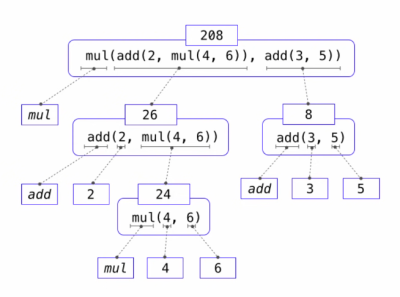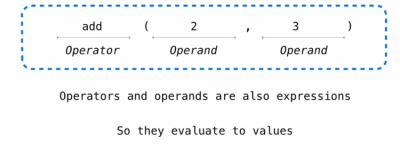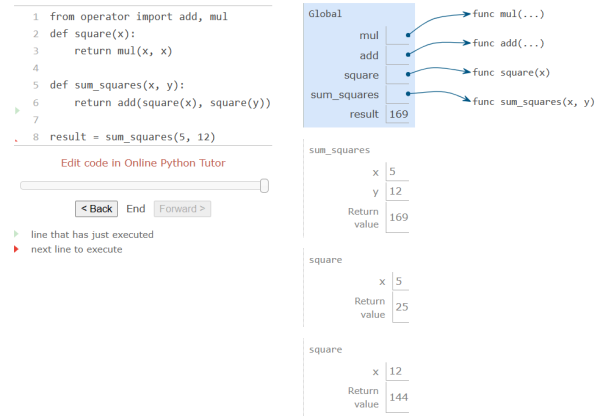目录
Welcome
week 1 notes
Python 基础
基本操作
<Control>-P(previous)<Control>-N(next)<Control>-Dexits a session
导入
# import lib from specific url
from urllib.request import urlopenElements of Programming
编程语言通常会提供三种方式来生成复杂的指令:
- primitive expressions and statements: 编程语言提供的最基础的单位
- means of combination: 由最简单的单位组合而成的复合指令
- means of astraction:复合指令可以被抽象,也就是将复合指令命名,并整合为一个单元来使用。
编程中的两种元素
- data:需要被操作的内容
- function:制定如何操作 data 的规则
expressions
表达式包括两种:
- primitive expressions:比如数字,通常以算数表达式的组合形式出现(operand + operator(infix) + operand)
- call expressions
call expressions
call exressions 是复合表达式的一种,是 $f(x)$ 的一般形式,指计算(mapping)的过程。其特点:
- 组成:函数的名字,括号,参数(argument)
- 参数可以有多个,如果有输出,输出也可以有多个。
- 可嵌套
- operator 指定了 function
- 执行的过程是 function 以指定的 argument 调用,并返回了值(value)
- argument 的顺序 matters
- 可以使用 function name 取代数学符号(infix notation)进行函数调用,没有歧义并调用方便
name and the environment
name 是一种用于关联 computational objects 的方式。name 可以通过与该对象绑定(binding)的方式来与其关联,从而达到通过 name 来操作该对象的目的。name 的绑定方式有 3 种:
- import:从外部导入已绑定的 name,使其对本地可见
- assignment:最简单的抽象方法;使用自定义的 name 和赋值操作,将 name 与对象关联
- define a function:以函数的方式将自定义的 name 与对象关联,对象通常是复合对象。
由于这种绑定关系的的存在,计算机需要分配一部分空间存储这些 name, object 以及关系。被分配的空间被称为环境(environment)。下面是 python 的示例:
#binding example
#import name with bound function
>>>from math import sqrt
>>>sqrt(256)
#assign name to a value
>>> radius = 10
#assgin name to an function
>>> max
#<built-in function max>
>>>f = max
#define a function
def square(x):
return x*xname in python
- built-in function 的 name 可以直接与其他对象绑定
- 每次修改 name 对应的数据时,都需要进行独立赋值。只修改一个 name 并不会影响其他 name 绑定的值:
>>> area, circumference = pi * radius * radius, 2 * pi * radius
>>> area
314.1592653589793
>>> radius = 11
>>> area
314.1592653589793
#another assignment needed for updating the value of area
>>> area = pi * radius * radius
380.132711084365- 赋值操作符右边的所有表达式都会在与 name 绑定之前先被衡量,比如下面的交换,
x,y先被取值,再进行了重新绑定:
>>> x, y = 3, 4.5
>>> y, x = x, y
>>> x
4.5
>>> y
3表达式解释的顺序
基础的解释顺序为:
- operator
- operand(可能是 primtive expr,也可能是 subexpression)
- subexpression 的 function (operator)
特点是:要计算主表达式,就得先计算出其子表达式的值。这种评估的过程被称为递归(recursive)
Nested Expressions
如果 operand 是子表达式(sub-expression),那么对该表达式按基础顺序继续执行,直到得到值(value)。例子如下:

该结构被称为表达式树(expression tree)
注意 CS 中树的构建是从上往下的,也就意味着求出根表达式需要求出其节点的值。而相比一半的算数式子,表达式的结构非常有利于解释执行(解释)的顺序,尤其是在多层嵌套的前提下。
注意事项
- environment 提供 name 的意义,以及评估 name 的环境。无意义的 name 参与的运算也是意义的
- statement 不会被评估,但会被执行(exxcuted);也就是说,statement 修改 name 的内容,但不会输出新的内容。比如:
# the operation does not return any values, but changes value of x
x = 3纯/非纯函数
纯函数(pure function)指有输入(argument)并会产生输出 (the result) 的函数,比如:
>>> abs(-2)
2- 纯函数只影响其输出结果(返回值)
- 相同参数的纯函数返回结果也相同
非纯函数(Non-pure functions)指应用时带有“副作用(side effects)” 的函数(通常指改变解释器状态)。打印是一种常见的副作用:
>>> print(1, 2, 3)
1 2 3print() 函数的打印值并不是其返回值。其返回值是 NoneType 类型的,值为 None 的变量:
>>> print(print(1), print(2))
1
2
None None纯函数的优点
- 在复合的情况下,纯函数会更可靠
- 纯函数可以更有效的被用于函数的嵌套中
- 纯函数测试起来简单(同样的 argument 永远都会返回对应的结果)
Defining New Functions
自定义函数是抽象过程中更加高级的做法。这种做法允许我们将 name 绑定到指定的复合指令集合上。比如这段程序:
>>> def square(x):
return mul(x, x)square 来抽象了让 x 自己乘以自己的过程。此处的 x 被称为 formal parameter,x 为自乘的数据提供了 name。
How to define a function
def <name>(<formal parameters>):
return <return expression>Environments
environments 通过一系列的 frame 来衡量表达式。以 frame 为单位,每个 frame 内部都会存储对应的 name,以及该 name 绑定的 value.
在 python 中,默认存在一个全局(golbal)frame。赋值 / 外部导入的 name 都会存储在这个 frame 中:

function 的 binding (无论是导入的,还是自定义的),也存储在这里:

我们将存储在 frame 中的 name 称为 bound name,而出现在函数内部的,同样的 name 称为 intrinsic name。每个函数可以同时存在多个 bound name,但 intrinsic name 有且只有一个。
注意事项
- bound name 会在评估期间完成绑定。
- Function Signatures:通过描述参数(formal parameter)的数量来区分同名的不同函数。
自定义函数的调用过程
考虑以下函数:
from operator import add, mul
def square(x):
return mul(x, x)
def sum_squares(x, y):
return add(square(x), square(y))
result = sum_squares(5, 12)- 首先,python 会评估 name
sum_squares. 此时sum_squares与自定函数绑定,其关系存储在 global frame 中。 - 当程序执行到调用
sum_square(),也就是result = sum_squares(5, 12)这一步时,此时:- 该调用创建了一个
sum_suqare()专属的 local frame - local frame 中保存了
sum_suqare()内部 operand 的绑定关系。此处是square()。需要注意的是这里的 operatoradd()是 built-in(外部导入的),因此其绑定存储在 global frame 中,而不是sun_square()的 local frame 中
- 接下来需要应用另外一个自定义函数
square(),因此针对该函数的绑定,需要再创建一个 Local frame 进行存储 - 执行完毕之后,将得到的结果一级一级往上反馈,最终得到最后结果:
- 存储与 global frame 中的 name 是可以共享的
- 基于 local frame 的 name,是独立的;比如上例中的
x,即便 name 相同,根据其所在的 local frame, 其绑定的 value 也不同。
Local names
函数的实现与其 formal parameter 无关。比如下面的两个函数实际上是同一个:
>>> def square(x):
return mul(x, x)
>>> def square(y):
return mul(y, y)- 避免了 formal parameter 的 name 与 global frame 中的 name 同名带来的问题。
- 确保了 formal parameter 是基于函数独立的;避免了多个函数之间因为参数重名而带来的冲突
我们将 local name 生效的区域(函数体)成为它的 scope。如果某个 name 无法被访问,那么我们就称其 out of scope。
python 命名的选择
- lowercase, spearated by underscores
- 函数名通常表示操作的类型(比如
print()),或是得到的结果(比如max) - argument 使用 lowercase, spearated by underscores,一个词的 name 更好
- argument 的名字同样也应该表意
- 不推荐使用单字母参数
函数与抽象
从之前的例子可以看到,我们在不考虑 square() 如何实现的情况下使用 sum_squares() 函数。我们将 square() 这种处于另一个函数内部的函数实现称之为函数抽象(functional abstraction)。从这点上来看,下面两个函数是没有区别的:
# these two functions are indistinguishable becuase of their return value
>>> def square(x):
return mul(x, x)
>>> def square(x):
return mul(x, x-1) + x函数抽象的概念
函数抽象需要考虑三个核心的属性:
- The domain of a function: 函数可以接受的参数范围
- The intent of function:函数的 input 与 output 之间的关系
- The range of a function: 函数返回值的取值范围
python 的运算符
/ /是 floor division,/是一般除法,分别对应floordiv()和truediv()
Designing Functions
函数设计应该遵循一个 idea:
functions are abstractions.
具体的来说:
- 每个函数应该只对应一项工作,该工作可以很简单的描述。多个工作应该使用多个函数实现
- DRY(do not repeat yourself)。逻辑只需要被实现一次,并反复应用;而不是到处拷贝该逻辑
- 函数应该被定义为更泛化的形式。比如比起
square()函数,我们应该实现的是pow()函数。因为指数运算包含了平方运算。
Documentation
python 中通常包括了函数的描述,这类 documentation 被称为 docstring:
- docstring 使用首尾三对双引号包含
- docstring 需要遵循缩进
>>> def pressure(v, t, n):
"""Compute the pressure in pascals of an ideal gas.
Applies the ideal gas law: http://en.wikipedia.org/wiki/Ideal_gas_law
v -- volume of gas, in cubic meters
t -- absolute temperature in degrees kelvin
n -- particles of gas
"""
k = 1.38e-23 # Boltzmann's constant
return n * k * t / v# 起头的信息被称为 Comments。
Docstring Conventions
Control statement
statement
statement 与 expression 在本质上有不同:
- 我们评估(evaluate) expression
- 我们执行(execute)statement
statement 意味着应用更改:比如赋值,返回等等。exrepssion 在被评估的时候也可以被视作 statement,但其生成的结果会丢失。比如:
>>> def square(x):
mul(x, x) # Watch out! This call doesn't return a valuereturn statement:
>>> def square(x):
return mul(x, x)Compound Statements
结构如下:
<header>:
<statement>
<statement>
...
<separating header>:
<statement>
<statement>
...
...
根据上述定义,def 属于 compound statement。
上述的结构可以被视作 sequence,也就是该结构总可以分为两个部分:
- 当前的 statement
- 余下的 statement
这是一种递归的结构。
Local Assignment
用户自定义的函数是在对应的 local frame 中运行的。local frame 在该函数被调用时创建;函数体中的 return statement 会起到重定向的作用。函数什么时候结束取决于
- 第一个
returnstatement 什么时候被执行 - 返回的值
赋值语句可以处于函数内部。任何函数内部的赋值,其绑定信息都存储于local frame,对外部的 name 不造成任何影响。
Conditional statement
if <expression>:
<suite>
elif <expression>:
<suite>
else:
<suite>- 首先会评估 header
- 某个 header 为 true, 则执行该 Header 下的 suite,其他的 suite 将会被跳过。
Iteration
while <expression>:
<suite>Testing
Assertions
python 中可以使用 assert statement 做验证。如果 assert 返回的对象为 True,那么什么也不会发生。否则,错误会被抛出:
>>> def fib_test():
assert fib(2) == 1, 'The 2nd Fibonacci number should be 1'
assert fib(3) == 1, 'The 3rd Fibonacci number should be 1'
assert fib(50) == 7778742049, 'Error at the 50th Fibonacci number'Doctest
docstring 中可以包含 test case,用于测试:
>>> def sum_naturals(n):
"""Return the sum of the first n natural numbers.
>>> sum_naturals(10)
55
>>> sum_naturals(100)
5050
"""
total, k = 0, 1
while k <= n:
total, k = total + k, k + 1
return total
>>> from doctest import testmod
>>> testmod()
TestResults(failed=0, attempted=2)
